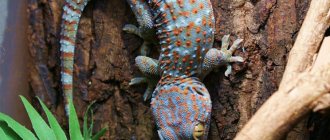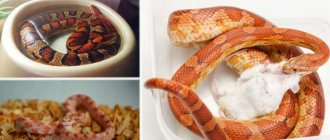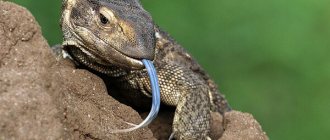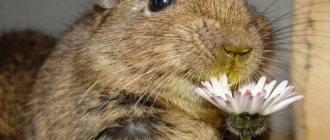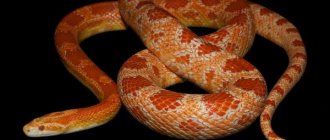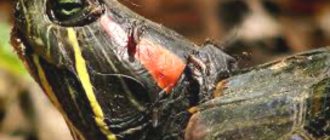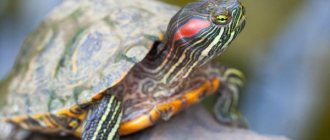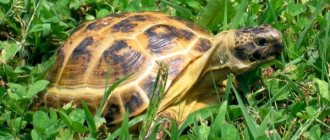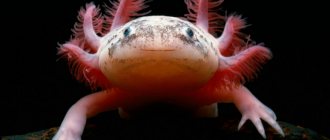In recent years, our compatriots have begun to show increased interest in exotic animals. Instead of the usual dogs and cats, terrariums inhabited by amphibians and reptiles began to appear in houses. The Cape monitor lizard is especially popular. After reading this article, you will learn about the peculiarities of keeping representatives of this species.
The Cape monitor lizard is one of the reptiles that is perfect for keeping at home. Unlike other monitor lizards, representatives of this species are more peaceful, easy to tame, and also get along well with children. Monitor lizards reproduce seasonally; babies are born in the spring. Therefore, the best time to buy a Cape monitor lizard would be mid-summer or autumn.
Spreading
Cape monitor lizards are distributed in field zones from west to east of central Africa, in Benin, Burkina Faso, Cameroon, Central African Republic, Chad, Democratic Republic of Congo (Zaire), Eritrea, Ethiopia, Gambia, Hanoi, Guinea, Guinea Bissau, Ivory Coast, Kenya, Liberia, Mali, Nigeria, Nigeria, Senegal, Sierra Leone, Sudan, Togo and Uganda.
Life in nature
In nature, Cape monitor lizards live in savanna and semi-desert biotopes, dry forests, rocky savannas, arid scrub (shrub thickets) and foothills. This lizard leads a terrestrial lifestyle, being active during the day. As a shelter, reptiles dig holes on their own, or use ready-made ones that belonged to rodents. Monitor lizards also settle among piles of stones, crevices and at the roots of trees and bushes. When an aggressor appears next to him, the Cape monitor lizard turns sideways to him, swells, bends his tail to the opposite side of the body and raises it to strike. If, when danger arises, the lizard cannot hide anywhere and thereby escape, it clings to the stones so tightly that it is almost impossible to tear it off. With the onset of a hot time of day, animals hide in their shelters and come out from there only with the onset of coolness. Cape monitor lizards can climb low into trees and bushes, where, hiding in a zone of relative ventilation, they can lie in wait for their prey. This species of animal is very territorial and therefore always adheres to the boundaries of its territory. In the wild, the lizard's diet consists mainly of carrion. They also hunt, catching small mammals, insects, frogs, crayfish and the like. The monitor lizard eats everything: from internal organs to bones. He does not chew food, but bites off large pieces of it and swallows. After the animal has eaten, it lies down half asleep to digest what it has eaten; at this moment the animal’s activity is reduced and it is relaxed. Monitor lizards show any activity only when they are in danger or hungry. This reptile is often found near rivers and lakes and, therefore, the local natives consider them sacred animals and believe that the death of these animals will lead to a decrease in the amount of water.
Natural habitat
These reptiles are widespread on the African continent. They can be seen in Nigeria, Kenya, Ethiopia and Sudan. The natural habitat of these lizards is considered to be foothills, rocky savannas, dry forests and semi-desert biotopes. They lead a terrestrial lifestyle and are active during the day. The shelter of Cape monitor lizards is often self-dug or ready-made holes that previously belonged to rodents. Often these reptiles settle in crevices, among stones and at the roots of bushes or trees. Local residents often see them near rivers or lakes.
In the heat, the Cape monitor lizard hides in its shelter, leaving it only after the onset of coolness. This lizard is very attached to its territory and always adheres to the boundaries of its own possessions. The basis of the diet of reptiles living in the wild is carrion. In addition, their prey can be crayfish, frogs, insects and even small mammals. Monitor lizards often climb low trees and lie in wait for their prey there. Having had their fill, they lie down to digest the swallowed pieces of food in a half-asleep state. During this period, the activity of lizards decreases to almost zero.
Appearance and dimensions
In the world of monitor lizards, Cape or, as they are also called, steppe monitor lizards are of medium size. In most cases, the body length of adult individuals does not exceed 1 m with a weight of 36–40 kg, but sometimes large specimens up to 130 cm are found. We are talking about males, which in size always prevail over females. It is characteristic that in captivity they reach much larger sizes than in the wild. Experts explain this fact by the absence of forced fasting and the balanced diet of the pet.
Some herpetologists, based on the natural habitats of Cape monitor lizards, distinguish 5 of their subspecies, which differ from each other in external characteristics. Most taxonomists recognize such a classification as inaccurate, leaning towards the integrity of the species. Researchers claim that all steppe lizards have common features: a wide head; long forked tongue; dense build; fine scaly covering over the entire body; short tail and neck; serrated ridge at the end of the tail; short muzzle; resembling narrow slits, obliquely set nostrils located very close to the eyes.
Important!
When keeping monitor lizards in captivity, it will not be possible to breed them - these reptiles simply do not want to reproduce.
Depending on the type of steppe lizard, the number of scales on its belly can vary from 60 to 160 pieces; The color also varies. Most often, individuals are gray-brown in color with yellow round spots located in a row on the back; usually they are edged with dark tones of the main color. And on the tail of the Cape monitor lizard there are yellow-brown rings. From below, his body, like the internal parts of all limbs, is distinguished by a light color.
The peculiarity of monitor lizards are excessively long claws on short fingers and powerful jaws; All representatives of this family have very developed jaw muscles. Experts draw the attention of breeders to the fact that in adult individuals the teeth are characterized by widened crowns and bluntness, while in young animals, on the contrary, they have pointed edges and a conical shape. Because of their beautiful skin, Cape monitor lizards have always aroused great interest among people. The peak of trade in these raw materials was recorded in the 70–80s of the twentieth century. Therefore, in some areas of their range, reptiles are included in the list of animals that are threatened with local extinction.
Meaning for humans
Man hunts the Cape monitor lizard primarily for meat and skins, but also for the animal trade. Between 1970 and 1990 The most common trade was in skins. However, in recent years the trade in skins appears to have declined and the trade in live animals has increased significantly. Young animals under 6 months of age are the primary target for the pet trade because they are cheaper to transport and easier to sell than larger animals.
Although there is no evidence that the trade in live African monitor lizards has a detrimental effect on wild populations, there are concerns that intensive trapping in small areas will lead to localized extinction.
Features of behavior
Thanks to its high level of intelligence, the young monitor lizard adapts relatively quickly to new living conditions. At first, he may show character and demonstrate aggression in the form of stances, hissing and attempts to bite the owner. However, you need to confidently dominate so that the pet understands the hierarchical relationships in the new home. A monitor lizard can be trained to be hand-fed, however, at first it will not only not eat, but will also begin to walk around the hand with food, hissing and trying to bite. After a bite, you can lightly flick him on the nose for educational purposes.
Training any animal requires enormous patience and calm persistence. Very soon the baby will learn obedience and stop showing aggression.
Monitor lizards can and should be walked outside. They will benefit from sunbathing and fresh air. The walking time should be gradually increased, accustoming the animal to new sensations. A young monitor lizard can easily run away from its owner, so it is recommended to use a special harness for walking, choosing a model for a kitten or small dog. On the street, you need to carefully watch the lizard, otherwise, even on a leash, it can climb where it shouldn’t.
Sunbathing should begin with five minutes, gradually increasing the time, since a reptile accustomed to the lamp may get sunburned.
What else is worth knowing?
Everyone knows that there are many people who like to keep exotic animals at home. No one keeps gray monitor lizards in apartment conditions, because they require special care. And only the person who knows the physiological characteristics of this lizard by heart can provide it.
Interestingly, Muslims are wary of gray monitor lizards. Their name in Turkic sounds like “kesel”. This word is translated as “disease”. And people believe that meeting a monitor lizard promises misfortune.
At one time, these creatures were on the verge of extinction. Many found the skin of monitor lizards unusually beautiful, which is difficult to disagree with. In addition, it is very durable. And monitor lizards were killed en masse to make shoes, wallets, bags and other accessories from their skins. At the beginning of the 20th century, 20 thousand individuals were destroyed per year. Then people realized what a horror they were committing and stopped killing these creatures. This is encouraging, although there are not as many representatives of the species left as before - in some places monitor lizards have already become extinct.
How to choose a Cape monitor lizard?
For better and faster adaptation, it is better to purchase a young individual. The best time for such a purchase is at the end of summer and autumn. When choosing a future pet, you need to pay special attention to the appearance and behavior of the individual you like. The reptile should be active and curious. Once in its native terrarium, the lizard must become interested in the food lying there. In human hands, a healthy monitor lizard will make active attempts to free itself. Before purchasing, it is advisable to inspect the mouth, nostrils and eyes of the reptile. A well-developed, healthy Cape monitor has a clean mouth that is a light lilac-pink color. Red or gray color indicates the possible presence of diseases. It is completely normal if the lizard starts to hiss. This is considered a sign of dissatisfaction. Among other things, it is recommended to carefully examine the claws and fingers of the reptile. They should not show any visible damage or defects.
Price
Africans offer, often bypassing the law, eggs and young animals of exotic animals. North American and European traders are buying everything. There is always demand from exotic lovers. Sellers of living goods successfully satisfy it.
The price of a Cape monitor lizard ranges from 5-10 thousand rubles. For such an exotic animal this is a small amount. The best time to purchase a monitor lizard is summer. During this season, you can get a young, recently born animal.
Visual inspection and observation of behavior will help select a healthy individual. No rashes, unnatural spots, discharge. A healthy baby is active, curious, and slightly aggressive in his hands. With age, as you get used to it, aggressiveness will be replaced by good nature. The owner will have an exotic cat substitute.
Maintenance and care
Those who prefer exotic pets to ordinary cats and dogs will like the monitor lizard. This is a very peace-loving reptile with a calm and interesting character, quite easy to train. However, all these qualities will only manifest themselves if you purchase a baby born in captivity. Domesticated wild animals can be dangerous and taming them will be very difficult.
Arrangement of the terrarium
The container for housing the lizard must correspond to its size. It’s good if it is 2 times longer than the reptile’s body. There are two ways to do this:
- Immediately purchase or glue together a terrarium 3-3.5 m long for growth.
- Place the young monitor lizard in a proportionate chamber, taking into account its current parameters. In this case, as it grows, it will have to be moved to larger terrariums.
In any case, the approximate size of the terrarium for a lizard about 30 cm long should be 60x30x30 cm. It should not be made lower, otherwise the monitor lizard will reach the heating devices with its paws and may tear them off.
As for the soil, it should hold moisture well. There are special mixtures for reptiles, but you can use coconut fibers or sphagnum moss. Some sources recommend pouring a fairly thick layer of soil so that the reptile can dig a hole for itself and live in conditions as close as possible to the natural environment. You can get by without this by putting up small shelters so that the pet feels protected at first. Later, when he gets used to the new place, the “houses” can be removed - they will no longer be needed.
For convenience and to create an interesting interior, you can place driftwood and branches in the terrarium. If decorative elements found in a forest or river are used, they must be washed well without the use of detergents and baked in the oven. If the soil is mixed with ordinary sand, the latter is also washed in running water several times, then heated on a tray or frying pan and only after cooling is used for its intended purpose.
Keeping a Cape monitor lizard will require the mandatory purchase of special equipment. Your pet will need:
- Ultraviolet and infrared lamps for overhead heating.
- A warm mat or heating cord for bottom heating of one half of the terrarium. The container should have zones with different temperature conditions so that the monitor lizard can move at will from warm to cool.
- A thermometer that attaches to the wall and allows you to control the heating.
- Water reservoir. Reptiles love to take baths, lying with their whole bodies in the water. In addition, their natural reflexes involve defecation into water, so a container with it will protect the soil from waste products. Thanks to this feature, it is very easy to train a monitor lizard to use the toilet - he will use the tray with water for his needs. If you take the monitor lizard every morning for 10-15 minutes in a bath of water at room temperature, then you can completely get rid of the need to remove feces from the terrarium tank.
- Stone or wooden house, shelter. You can also cover the floor with an artificial rug that imitates grass.
Humidity should always be maintained at a high level. If the monitor lizard drinks a lot, it means that it does not have enough moisture, so you need to spray the soil more often with a spray bottle and reduce ventilation.
Temperature conditions must be observed - poorly heated air and floors cause digestive problems. Half of the bottom of the terrarium should warm up to +40 °C during the day, while the daytime air temperature is at least +28 °C. At night, the heating can be turned off, but you must ensure that the temperature does not fall below +20 °C, especially if it is cold in the apartment. In this case, it is better to leave the night heating on. It is safer for the health of the Cape monitor lizard than a lack of heat.
Hunting
So, above we have listed what the gray monitor lizard eats. Now we can say a few words about exactly how this creature hunts.
If a lizard has chosen a large snake as a victim, it will adhere to certain tactics. First, he will tire her with false attempts to attack - he will make approaches from different sides, like a mongoose. And then, when the snake gets tired, it will jump on it and grab its head with its teeth (or a little further). Immediately the monitor lizard will begin to shake the victim and hit it against the ground or stones. He needs the victim to stop resisting. Sometimes, to do this, he can simply hold it in his teeth, squeezing his jaws until the snake weakens. Nothing will happen to the monitor lizard from the response (bite). If the snake tries to “wrap” the hunter in a ring to strangle him, he will easily dodge.
When a monitor lizard hunts, it tries to stick to an already proven route. During his “research” he checks rodent burrows, bird nests, and gerbil colonies. However, if nothing can be found, the reptile will not disdain carrion.
Feeding the Cape monitor lizard
Monitor lizards are predators by nature. And they spend most of their time searching for food. The pet must be active and slim. But laziness and constant access to food leads to rapid obesity. It is worth paying great attention to the diet, since the process of weight gain for these animals is almost irreversible.
Even if you put him on a diet, he will not be able to lose weight like mammals.
All internal organs of the animal are covered with fat. Monitor lizards have a rather small heart compared to their entire body. By burdening your movement with weight, there is a large load on your pet's heart. The circulatory system is not able to withstand such loads, which leads to ruptures of blood vessels. The blood forms a diamond and can get anywhere in the animal’s body, including the lungs. The outcome of such an incident is always fatal.
The Cape monitor lizard should not be overfed, as its colon is very thin. And sometimes in a situation where the pet is obese and also receives a large portion of food, intestinal rupture can occur.
Diet selection
The diet should include:
- Insects.
- Rodents.
- Meat.
- Feeding with vitamins.
The pet's menu may also include mice, rats, shrimp, eggs, as well as pieces of boiled chicken meat without fat. They also eat rabbit meat, beef and offal.
Do not feed fatty foods such as pork or lard. You should also not give eggs frequently, as they put a heavy burden on the liver for the Cape monitor lizard, and eggs also contain cholesterol.
Cubs up to 3-4 months can be allowed to feed once or twice a day. Light food until 9-10 months of age is given every other day. You can alternate feeding insects with meat.
Animals over 1 year old are fed once a week.
It is advisable to protect your pet from feeding food caught on the street. Frogs, toads and snails very often have helminths in their intestines; by eating such food, a monitor lizard can become seriously poisoned, as well as become infected with worms.
Do not forget about feeding the animal with vitamins. These reptiles require calcium for good development.
What to feed your reptile?
Many inexperienced owners make serious mistakes when preparing their pet’s diet. This often leads to the death of the lizard. Those who care about their monitor lizard (Cape) should approach issues related to its nutrition with the utmost responsibility. The diet of a tamed reptile should consist of slugs, snails, cockroaches, earthworms, locusts and crickets. Occasionally you can pamper your pet with chicken, lean fish, mice or frogs.
In addition, it is advisable to add fortified supplements containing calcium to the main menu. Growing reptiles need to be fed small portions several times a day. Adults need to be fed two to three times a week. Otherwise, they may be at risk of obesity.
Taming
The Cape monitor lizard has a fairly high intelligence, so it socializes very easily and quickly. It will not be difficult for the owner to control the predictable behavior of his pet. It is necessary to be as philosophical as possible about aggressive stances and tail strikes, without allowing the reptile to take a dominant position. At first, the baby may hiss around your hand with outstretched food. It is very important to show maximum patience and over time he will get used to taking food. If he manages to bite you, then you need to not hurt, but noticeably flick him on the nose. The kid will quickly remember this lesson and next time he will think carefully about whether it is necessary to show aggression.
What to feed your reptile?
Many inexperienced owners make serious mistakes when preparing their pet’s diet. This often leads to the death of the lizard. Those who care about their monitor lizard (Cape) should approach issues related to its nutrition with the utmost responsibility. The diet of a tamed reptile should consist of slugs, snails, cockroaches, earthworms, locusts and crickets. Occasionally you can pamper your pet with chicken, lean fish, mice or frogs.
In addition, it is advisable to add fortified supplements containing calcium to the main menu. Growing reptiles need to be fed small portions several times a day. Adults need to be fed two to three times a week. Otherwise, they may be at risk of obesity.
A few words about walks
Some owners regularly walk their monitor lizards. To do this, you need to purchase a correctly sized harness for kittens. Lizards are skilled at backing up, so they should not be left outside unattended. It is advisable to walk with the reptile in warm weather. In the summer, sunbathing is recommended for the monitor lizard. But a lizard accustomed to artificial ultraviolet light should be accustomed to the real sun gradually so as not to cause burns. At first, you can limit yourself to fifteen-minute walks, gradually increasing the time spent in the fresh air.
Did you know? Lizards have lived on Earth for hundreds of millions of years. The oldest fossil lizard, named Lizzie, lived about 340 million years ago. It was discovered in Scotland in 1988.
Enemies in the wild
To survive in the wild, monitor lizards use their sharp claws, strong teeth, powerful tail and extreme agility. It is only at first glance that this large lizard seems clumsy - in fact, if necessary, it can quickly run, swim and climb vertical surfaces with lightning speed. Thanks to this set of qualities, the predator is afraid of few people in its habitat, although it spends most of its life in a hole. These are solitary animals that are not friendly even with their fellow animals, because they consider them as competitors in obtaining food. When reptiles meet, a fight is sure to occur, accompanied by hissing, lashing of tails and distended bellies. In this case, victory will go to the strongest. It is possible that the victim will be immediately eaten. In relation to other representatives of the fauna, these reptiles are most vulnerable to crocodiles, since they hunt their eggs.
Monitor lizards can also be attacked by large birds of prey and snakes. But they are more interested in young lizards. Forced to fight, Cape monitor lizards fight back with their tails and bite. Their bite is deadly due to the many bacteria that develop on food debris in the host’s mouth; At the same time, the resulting pathogenic microflora does not threaten his health at all. And for humans and other animals, such a wound can result in blood poisoning and death. It is believed that reptiles subsequently find their prey by smell. Did you know? When faced with a strong opponent who does not back down with a threatening hiss and wagging tail, the Cape monitor lizard can pretend to be dead.
Natural habitat
These reptiles are widespread on the African continent. They can be seen in Nigeria, Kenya, Ethiopia and Sudan. The natural habitat of these lizards is considered to be foothills, rocky savannas, dry forests and semi-desert biotopes. They lead a terrestrial lifestyle and are active during the day. The shelter of Cape monitor lizards is often self-dug or ready-made holes that previously belonged to rodents. Often these reptiles settle in crevices, among stones and at the roots of bushes or trees. Local residents often see them near rivers or lakes.
In the heat, the Cape monitor lizard hides in its shelter, leaving it only after the onset of coolness. This lizard is very attached to its territory and always adheres to the boundaries of its own possessions. The basis of the diet of reptiles living in the wild is carrion. In addition, their prey can be crayfish, frogs, insects and even small mammals. Monitor lizards often climb low trees and lie in wait for their prey there. Having had their fill, they lie down to digest the swallowed pieces of food in a half-asleep state. During this period, the activity of lizards decreases to almost zero.
Reproduction
Puberty in steppe lizards occurs closer to the age of three. Their mating season begins annually during the rainy season, when vital activity increases. The male tries in every possible way to attract the attention of the female he likes - for this purpose he constantly chases her, and also bites her tail, scratches her neck and legs. After mating, the female digs a shallow nest and lays from 20 to 60 eggs, up to 10 cm in size. Their incubation lasts for six months, and with the onset of spring a brood appears in the hole. It is characteristic that newborn lizards are characterized by complete independence, as well as intensive growth, which lasts the first 2 months after hatching. At the same time, parents do not care at all about their offspring.
Lifestyle
Deserts and semi-deserts are where the gray monitor lizard is most often found. What are the features of his appearance - it was said at the very beginning of the article, and with this appearance he can easily hide from more predatory animals. Most often, these lizards can be found on semi-fixed or fixed sands, and a little less often on clay soils.
Monitor lizards try to stick to river valleys, foothills, ravines, and tugai thickets. And they cannot be found in areas where there is dense vegetation. True, they visit rare forest areas. But they will certainly never live in those places that are adjacent to human habitations.
Gray monitor lizards take refuge in the same burrows where turtles and rodents used to live. They can “settle” in a hollow or bird’s nest. But they look for ready-made housing, as a rule, in clay deserts. Because it is difficult for them to dig their own hole there. But in sandy deserts - no. There, monitor lizards dig holes, the depth of which can reach several meters. They hibernate there during the winter. And so that no one gets into the hole, they close it with a plug made of earth.
